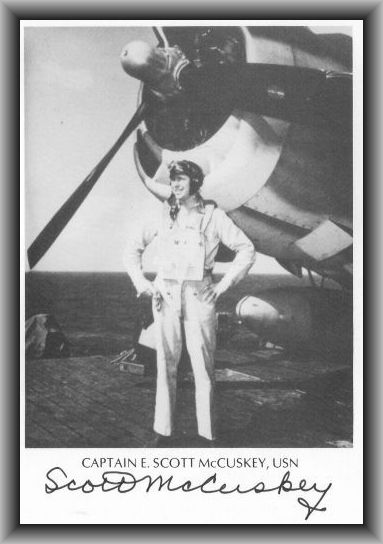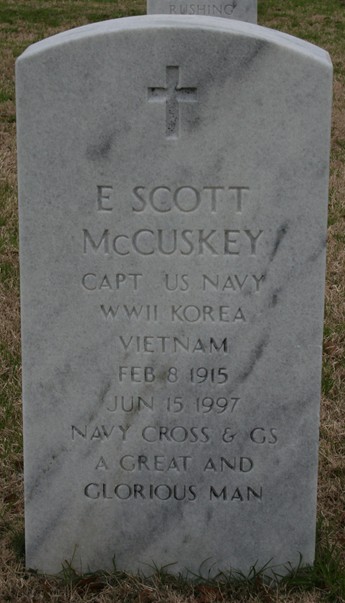The "Fighting Eight" (VF-8) while attached to the USS Bunker Hill, flying F6F "Hellcats" achieved significant success throughout the Pacific from March through October, 1944, gaining 153 aerial victories with the loss of only two pilots in aerial combat. The anti-blackout suir was also introduced to VF-8 by McCuskey. In early 1955, he initiated and prepared the first staff study on the Submerged Launch Submarine Ballistic Missile System.
He was a Graduate of the Air War College and Industrial College of the Armed Forces, and later served on their staff and faculty. After retirement in 1965, Doctor McCuskey was associated with Community College Education.
His decorations included two Navy Crosses, four Distinguished Flying Crosses and eleven Air Medals.
Aerial Combat: The Battle of Midway, June 4, 1942. After a scramble launch from the USS Yorktown, he personally intercepted 18 Japanese Val dive bombers approximately 10 miles from his ship. Pressing home his attack, he closed within point blank range of the aircraft in the first chutai, to avoid colliding with the second chutai, shooting down 3 on his initial pass and causing the formation to break up. He then engaged numerous "Vals", who had dropped their bombs on their target, in a wild dog-fight until expending his ammunition, at which time he had two "Vals" on his tail. He was able to break off the engagement by diving for the water. He was credited with 3 kills and 3 probables during thie engagement.
During World War II, McCuskey was designated an "Ace", with 14 confirmed kills.
(bio provided by chuck cummins)
Military Information: CAPT, US NAVY
The "Fighting Eight" (VF-8) while attached to the USS Bunker Hill, flying F6F "Hellcats" achieved significant success throughout the Pacific from March through October, 1944, gaining 153 aerial victories with the loss of only two pilots in aerial combat. The anti-blackout suir was also introduced to VF-8 by McCuskey. In early 1955, he initiated and prepared the first staff study on the Submerged Launch Submarine Ballistic Missile System.
He was a Graduate of the Air War College and Industrial College of the Armed Forces, and later served on their staff and faculty. After retirement in 1965, Doctor McCuskey was associated with Community College Education.
His decorations included two Navy Crosses, four Distinguished Flying Crosses and eleven Air Medals.
Aerial Combat: The Battle of Midway, June 4, 1942. After a scramble launch from the USS Yorktown, he personally intercepted 18 Japanese Val dive bombers approximately 10 miles from his ship. Pressing home his attack, he closed within point blank range of the aircraft in the first chutai, to avoid colliding with the second chutai, shooting down 3 on his initial pass and causing the formation to break up. He then engaged numerous "Vals", who had dropped their bombs on their target, in a wild dog-fight until expending his ammunition, at which time he had two "Vals" on his tail. He was able to break off the engagement by diving for the water. He was credited with 3 kills and 3 probables during thie engagement.
During World War II, McCuskey was designated an "Ace", with 14 confirmed kills.
(bio provided by chuck cummins)
Military Information: CAPT, US NAVY
Inscription
NAVY CROSS
Gravesite Details
WORLD WAR II, KOREA & VIETNAM
Family Members
Sponsored by Ancestry
Advertisement
Advertisement















